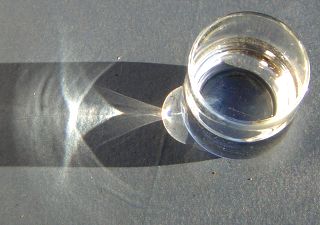|
Capillary Wave
A capillary wave is a wave traveling along the phase boundary of a fluid, whose dynamics and phase velocity are dominated by the effects of surface tension. Capillary waves are common in nature, and are often referred to as ripples. The wavelength of capillary waves on water is typically less than a few centimeters, with a phase speed in excess of 0.2–0.3 meter/second. A longer wavelength on a fluid interface will result in gravity–capillary waves which are influenced by both the effects of surface tension and gravity, as well as by fluid inertia. Ordinary gravity waves have a still longer wavelength. When generated by light wind in open water, a nautical name for them is cat's paw waves. Light breezes which stir up such small ripples are also sometimes referred to as cat's paws. On the open ocean, much larger ocean surface waves (seas and swells) may result from coalescence of smaller wind-caused ripple-waves. Dispersion relation The dispersion relation describes ... [...More Info...] [...Related Items...] OR: [Wikipedia] [Google] [Baidu] |
Dispersion Relation
In the physical sciences and electrical engineering, dispersion relations describe the effect of dispersion on the properties of waves in a medium. A dispersion relation relates the wavelength or wavenumber of a wave to its frequency. Given the dispersion relation, one can calculate the phase velocity and group velocity of waves in the medium, as a function of frequency. In addition to the geometry-dependent and material-dependent dispersion relations, the overarching Kramers–Kronig relations describe the frequency dependence of wave propagation and attenuation. Dispersion may be caused either by geometric boundary conditions (waveguides, shallow water) or by interaction of the waves with the transmitting medium. Elementary particles, considered as matter waves, have a nontrivial dispersion relation even in the absence of geometric constraints and other media. In the presence of dispersion, wave velocity is no longer uniquely defined, giving rise to the distinction of phase ... [...More Info...] [...Related Items...] OR: [Wikipedia] [Google] [Baidu] |
Hydrodynamics
In physics and engineering, fluid dynamics is a subdiscipline of fluid mechanics that describes the flow of fluids—liquids and gases. It has several subdisciplines, including ''aerodynamics'' (the study of air and other gases in motion) and hydrodynamics (the study of liquids in motion). Fluid dynamics has a wide range of applications, including calculating forces and moments on aircraft, determining the mass flow rate of petroleum through pipelines, predicting weather patterns, understanding nebulae in interstellar space and modelling fission weapon detonation. Fluid dynamics offers a systematic structure—which underlies these practical disciplines—that embraces empirical and semi-empirical laws derived from flow measurement and used to solve practical problems. The solution to a fluid dynamics problem typically involves the calculation of various properties of the fluid, such as flow velocity, pressure, density, and temperature, as functions of space and time. Bef ... [...More Info...] [...Related Items...] OR: [Wikipedia] [Google] [Baidu] |
The Feynman Lectures On Physics
''The Feynman Lectures on Physics'' is a physics textbook based on some lectures by Richard Feynman, a Nobel laureate who has sometimes been called "The Great Explainer". The lectures were presented before undergraduate students at the California Institute of Technology (Caltech), during 1961–1963. The book's co-authors are Feynman, Robert B. Leighton, and Matthew Sands. ''The Feynman Lectures on Physics'' is perhaps the most popular physics book ever written. More than 1.5 million English-language copies have been sold; probably even more copies have been sold in a dozen foreign-language editions. A 2013 review in ''Nature'' described the book as having "simplicity, beauty, unity ... presented with enthusiasm and insight". Description The textbook comprises three volumes. The first volume focuses on mechanics, radiation, and heat, including relativistic effects. The second volume covers mainly electromagnetism and matter. The third volume covers quantum mechanics; for exam ... [...More Info...] [...Related Items...] OR: [Wikipedia] [Google] [Baidu] |
Richard Feynman
Richard Phillips Feynman (; May 11, 1918 – February 15, 1988) was an American theoretical physicist, known for his work in the path integral formulation of quantum mechanics, the theory of quantum electrodynamics, the physics of the superfluidity of supercooled liquid helium, as well as his work in particle physics for which he proposed the parton model. For contributions to the development of quantum electrodynamics, Feynman received the Nobel Prize in Physics in 1965 jointly with Julian Schwinger and Shin'ichirō Tomonaga. Feynman developed a widely used pictorial representation scheme for the mathematical expressions describing the behavior of subatomic particles, which later became known as Feynman diagrams. During his lifetime, Feynman became one of the best-known scientists in the world. In a 1999 poll of 130 leading physicists worldwide by the British journal ''Physics World'', he was ranked the seventh-greatest physicist of all time. He assisted in the development o ... [...More Info...] [...Related Items...] OR: [Wikipedia] [Google] [Baidu] |
Caustic (optics)
In optics, a caustic or caustic network is the envelope of light rays which have been reflected or refracted by a curved surface or object, or the projection of that envelope of rays on another surface. The caustic is a curve or surface to which each of the light rays is tangent, defining a boundary of an envelope of rays as a curve of concentrated light. Therefore, in the photo to the right, caustics can be seen as patches of light or their bright edges. These shapes often have cusp singularities. Explanation Concentration of light, especially sunlight, can burn. The word ''caustic'', in fact, comes from the Greek καυστός, burnt, via the Latin ''causticus'', burning. A common situation where caustics are visible is when light shines on a drinking glass. The glass casts a shadow, but also produces a curved region of bright light. In ideal circumstances (including perfectly parallel rays, as if from a point source at infinity), a nephroid-shaped patch of light ... [...More Info...] [...Related Items...] OR: [Wikipedia] [Google] [Baidu] |
Water
Water (chemical formula ) is an inorganic, transparent, tasteless, odorless, and nearly colorless chemical substance, which is the main constituent of Earth's hydrosphere and the fluids of all known living organisms (in which it acts as a solvent). It is vital for all known forms of life, despite not providing food, energy or organic micronutrients. Its chemical formula, H2O, indicates that each of its molecules contains one oxygen and two hydrogen atoms, connected by covalent bonds. The hydrogen atoms are attached to the oxygen atom at an angle of 104.45°. "Water" is also the name of the liquid state of H2O at standard temperature and pressure. A number of natural states of water exist. It forms precipitation in the form of rain and aerosols in the form of fog. Clouds consist of suspended droplets of water and ice, its solid state. When finely divided, crystalline ice may precipitate in the form of snow. The gaseous state of water is steam or water vapor. Water co ... [...More Info...] [...Related Items...] OR: [Wikipedia] [Google] [Baidu] |
Group Velocity
The group velocity of a wave is the velocity with which the overall envelope shape of the wave's amplitudes—known as the ''modulation'' or ''envelope'' of the wave—propagates through space. For example, if a stone is thrown into the middle of a very still pond, a circular pattern of waves with a quiescent center appears in the water, also known as a capillary wave. The expanding ring of waves is the wave group, within which one can discern individual waves that travel faster than the group as a whole. The amplitudes of the individual waves grow as they emerge from the trailing edge of the group and diminish as they approach the leading edge of the group. Definition and interpretation Definition The group velocity is defined by the equation: :v_ \ \equiv\ \frac\, where is the wave's angular frequency (usually expressed in radians per second), and is the angular wavenumber (usually expressed in radians per meter). The phase velocity is: . The function , which gi ... [...More Info...] [...Related Items...] OR: [Wikipedia] [Google] [Baidu] |
Atwood Number
The Atwood number (A) is a dimensionless number in fluid dynamics used in the study of hydrodynamic instabilities in density stratified flows. It is a dimensionless density ratio defined as : \mathrm = \frac where : \rho_1 = density of heavier fluid : \rho_2 = density of lighter fluid Field of application Atwood number is an important parameter in the study of Rayleigh–Taylor instability and Richtmyer–Meshkov instability The Richtmyer–Meshkov instability (RMI) occurs when two fluids of different density are impulsively accelerated. Normally this is by the passage of a shock wave. The development of the instability begins with small amplitude perturbations which .... In Rayleigh–Taylor instability, the penetration distance of heavy fluid bubbles into the light fluid is a function of acceleration time scale, \mathrm g t^2 where ''g'' is the gravitational acceleration and ''t'' is the time. References Dimensionless numbers of fluid mechanics Fluid dynamics ... [...More Info...] [...Related Items...] OR: [Wikipedia] [Google] [Baidu] |
Mass Density
Density (volumetric mass density or specific mass) is the substance's mass per unit of volume. The symbol most often used for density is ''ρ'' (the lower case Greek letter rho), although the Latin letter ''D'' can also be used. Mathematically, density is defined as mass divided by volume: : \rho = \frac where ''ρ'' is the density, ''m'' is the mass, and ''V'' is the volume. In some cases (for instance, in the United States oil and gas industry), density is loosely defined as its weight per unit volume, although this is scientifically inaccurate – this quantity is more specifically called specific weight. For a pure substance the density has the same numerical value as its mass concentration. Different materials usually have different densities, and density may be relevant to buoyancy, purity and packaging. Osmium and iridium are the densest known elements at standard conditions for temperature and pressure. To simplify comparisons of density across different systems ... [...More Info...] [...Related Items...] OR: [Wikipedia] [Google] [Baidu] |
Dispersion Capillary
Dispersion may refer to: Economics and finance *Dispersion (finance), a measure for the statistical distribution of portfolio returns *Price dispersion, a variation in prices across sellers of the same item *Wage dispersion, the amount of variation in wages encountered in an economy *Dispersed knowledge, notion that any one person is unable to perceive all economic forces Science and mathematics Mathematics *Statistical dispersion, a quantifiable variation of measurements of differing members of a population **Index of dispersion, a normalized measure of the dispersion of a probability distribution *Dispersion point, a point in a topological space the removal of which leaves the space highly disconnected Physics *The dependence of wave velocity on frequency or wavelength: **Dispersion (optics), for light waves **Dispersion (water waves), for water waves **Acoustic dispersion, for sound waves **Dispersion relation, the mathematical description of dispersion in a system **Modal dis ... [...More Info...] [...Related Items...] OR: [Wikipedia] [Google] [Baidu] |
Wavenumber
In the physical sciences, the wavenumber (also wave number or repetency) is the ''spatial frequency'' of a wave, measured in cycles per unit distance (ordinary wavenumber) or radians per unit distance (angular wavenumber). It is analogous to temporal frequency, which is defined as the number of wave cycles per unit time (''ordinary frequency'') or radians per unit time (''angular frequency''). In multidimensional systems, the wavenumber is the magnitude of the ''wave vector''. The space of wave vectors is called ''reciprocal space''. Wave numbers and wave vectors play an essential role in optics and the physics of wave scattering, such as X-ray diffraction, neutron diffraction, electron diffraction, and elementary particle physics. For quantum mechanical waves, the wavenumber multiplied by the reduced Planck's constant is the ''canonical momentum''. Wavenumber can be used to specify quantities other than spatial frequency. For example, in optical spectroscopy, it is often used ... [...More Info...] [...Related Items...] OR: [Wikipedia] [Google] [Baidu] |



.gif)